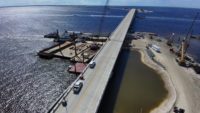Disaster Response
Sanibel Causeway Repair: Contractors Flooded Site With Crews, Resources

Photo courtesy Superior Construction Co.
After Hurricane Ian slammed into southwest Florida, washing out the Sanibel Causeway and cutting off thousands of Sanibel Island residents, another flood hit the area: construction crews and resources that swarmed the area to rebuild two roadway sections and five washed-out approaches to restore access.
The onslaught of resources worked, with contractors and engineering firms successfully completing causeway work in less than one month after the storm and almost two weeks ahead of schedule.
The work was completed by a joint venture of Jacksonville, Fla.-based Superior Construction and Miami-based The de Moya Group, along with Ajax Paving, Fort Myers, Fla. The Florida Dept. of Transportation (FDOT) also has contracted Superior/de Moya for progressive design-build of the causeway's permanent repair, says Ryan Hamrick, Superior's division manager.
The hurricane had washed away two large sections at the northernmost end of the causeway, Hamrick says, and five approach slabs were severely damaged, as was the connection to Sanibel Island. Sea walls crumbled around those sections of approach slabs, but the primary work to reopen the causeway was repair it and all approach slabs. The two islands along the causeway also had significant breaches.
Emergency repairs were completed and the three-mile-long causeway reopened for roughly 6,000 island residents on Oct. 19. Repairs were prioritized by FDOT, per an Oct. 4 directive from Florida Gov. Ron DeSantis. Completion of the work 15 days later exceeded the target date of Oct. 31.
The multifaceted approach included working from the mainland out, as well as by approaching various areas along the causeway by using marine equipment to bring in rip rap and other material, excavators and loaders. Temporary sheet piles were used as crews built the travel surface back.
“The approach there was just pounding the effort with resources,” Hamrick says.
Washed-out material was dredged up and relocated on both islands to rebuild causeways, he says, with work continuing 24/7 and the team logging around 36,000 worker hours with close to 150 personnel from the joint venture alone.
With temporary repairs in place, Hamrick says the Superior/de Moya JV is turning its focus to plans for permanent repairs, although no timeline is yet in place for that work. He estimates that the project team will submit its designs to FDOT within the next few weeks.
“Once we got that completed [Oct.19], the focus turned to the more permanent, resilient design for the causeway,” he says. “We’re working with our design engineers to focus on critical areas we want to build first, to get those wrapped up and submitted to FDOT.”
All work is being done under one phased design-build, or progressive design-build contract, Hamrick says, with no set final value. Resilience in the face of future storms will be a big part of the design for permanent causeway repairs, says the manager, who was on the scene within a few days after the storm to view damage and assist FDOT with assessments.
“Pictures don’t really do it justice,” he says. “Seeing it with your own eyes gives you a great appreciation for storm surge and what it can do to the structures we build every day.”
It was an eye-opening experience, Hamrick says, as was seeing the emergency and cleanup efforts that followed, which he describes as impressive, crediting teams from FDOT, emergency crews and others.
“It was impressive to see the cohesiveness,” he says, noting that work was all done amid the extra challenge that came from working in an area that had been so severely ravaged by Ian.
“Everything that would not typically be a challenge on a job: accessing, just driving to the job site took hours,” Hamrick says. “Housing for the crews, meals, how to get equipment and fuel to the job site, everything was a challenge. But everything was overcome because every person on the job site from top to bottom was working to help the community reestablish the connection to the island.”




